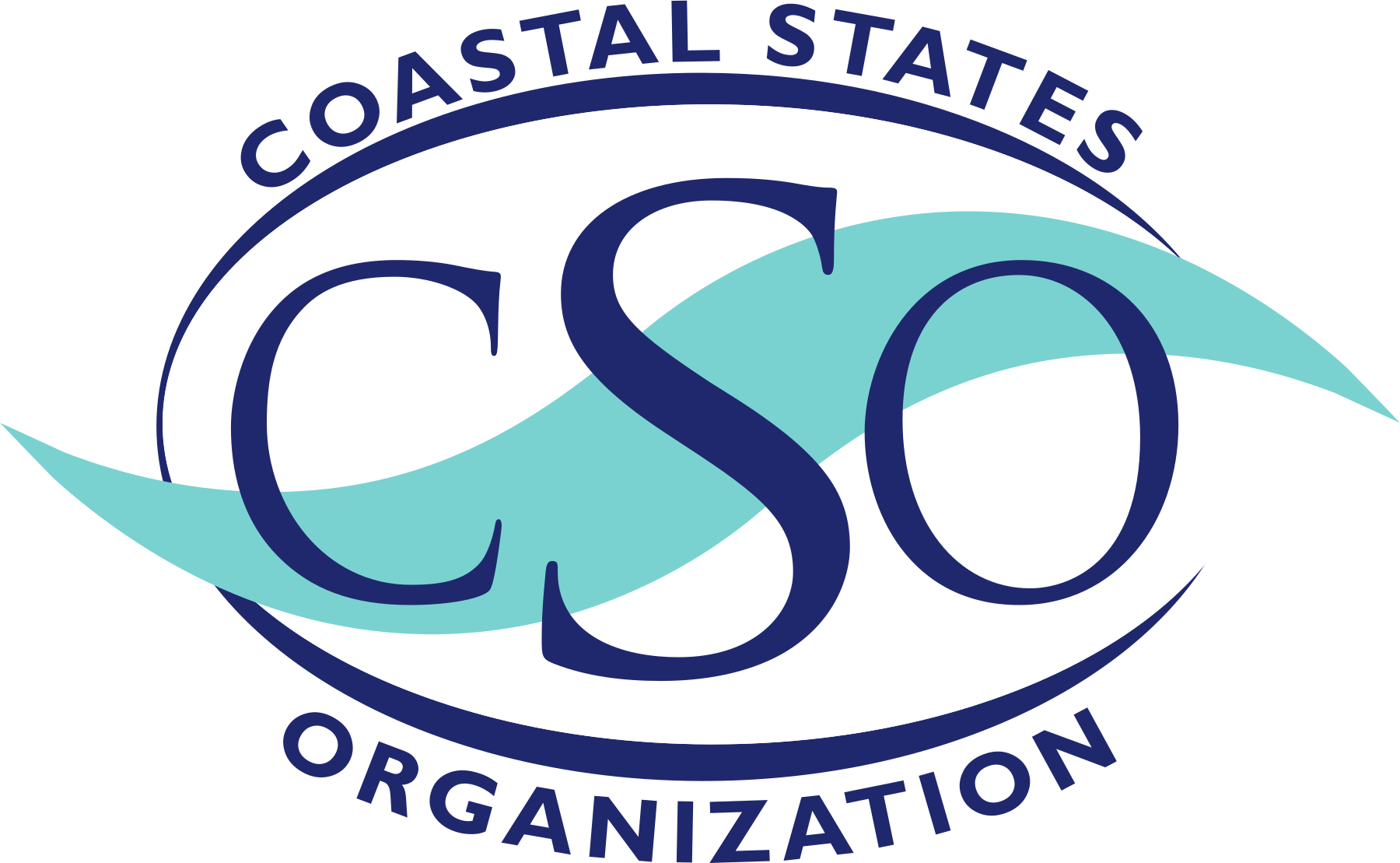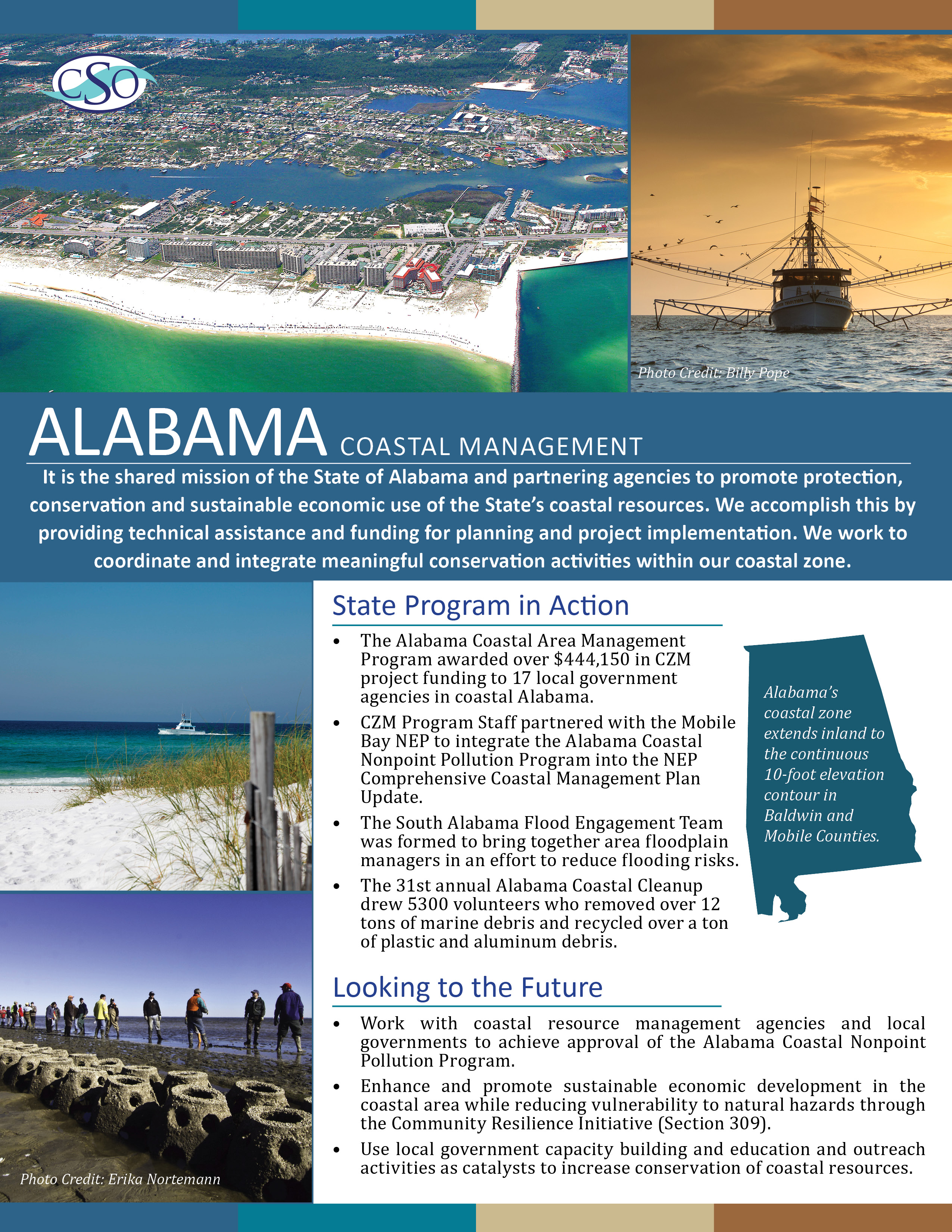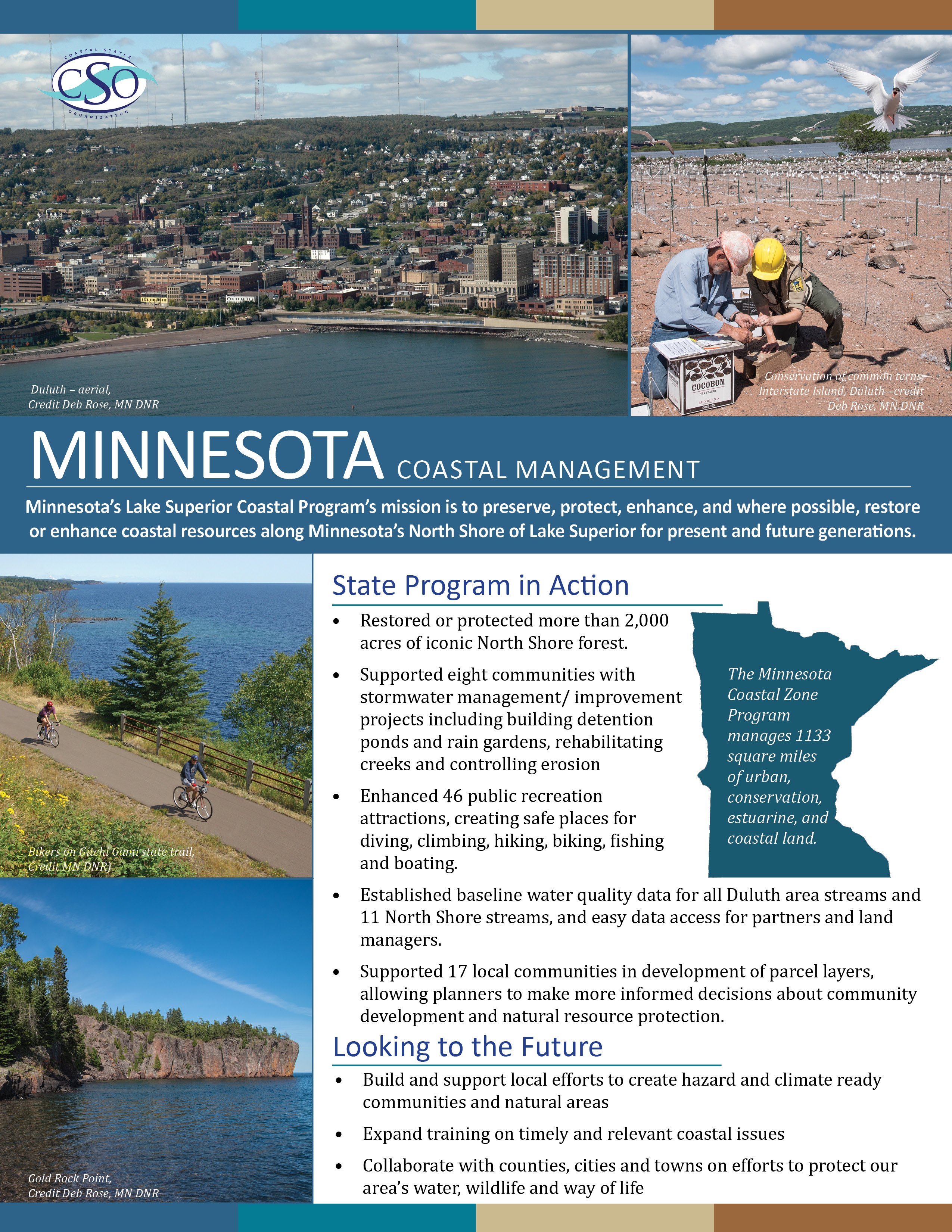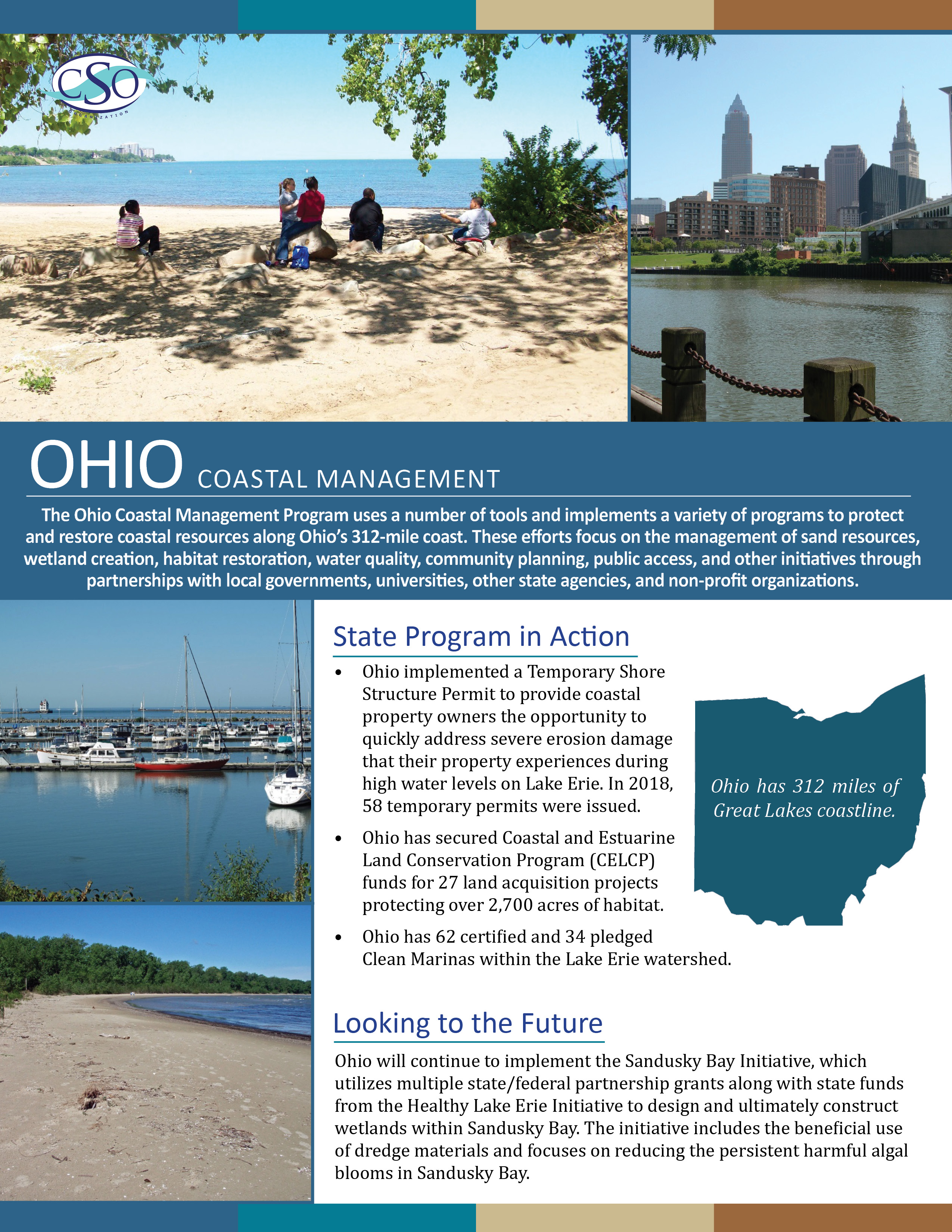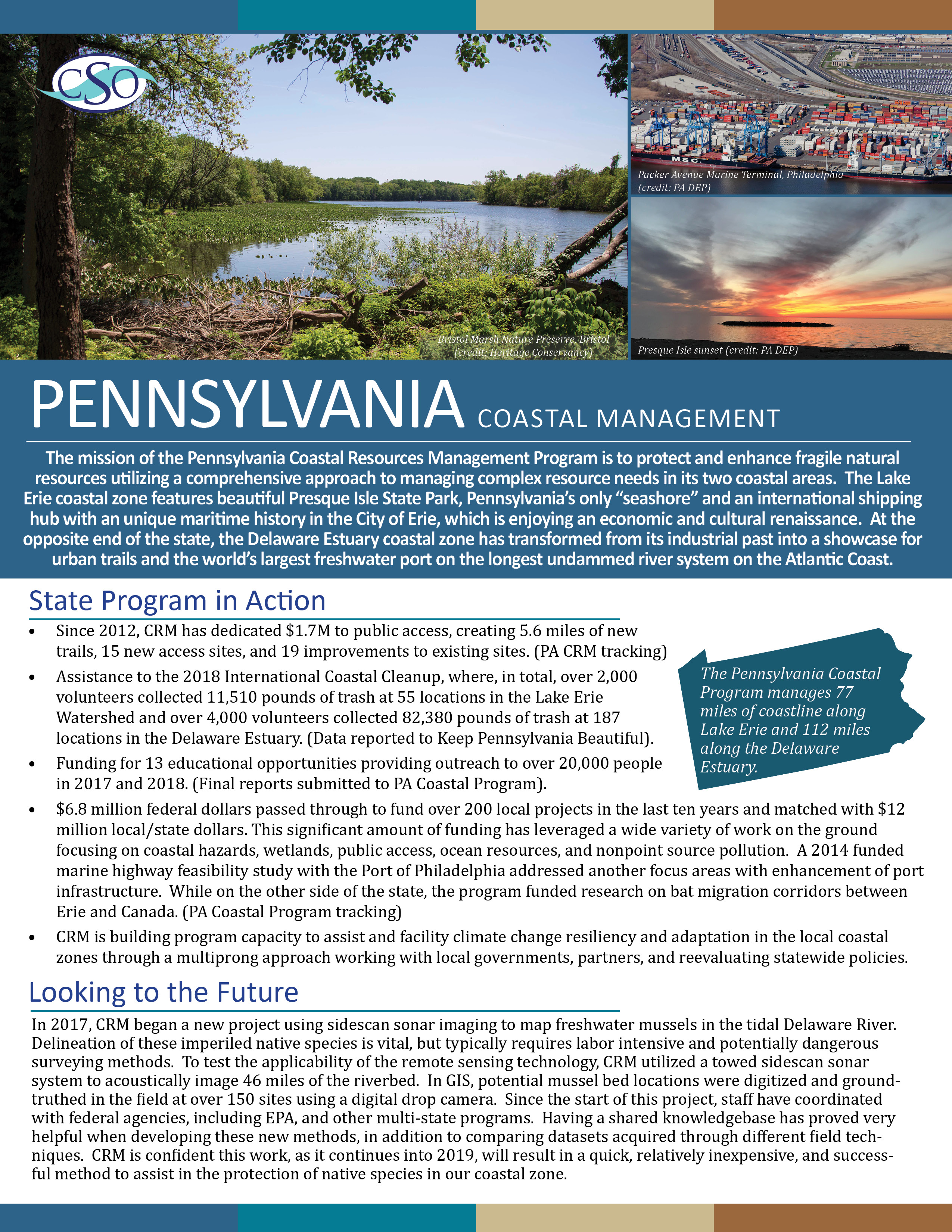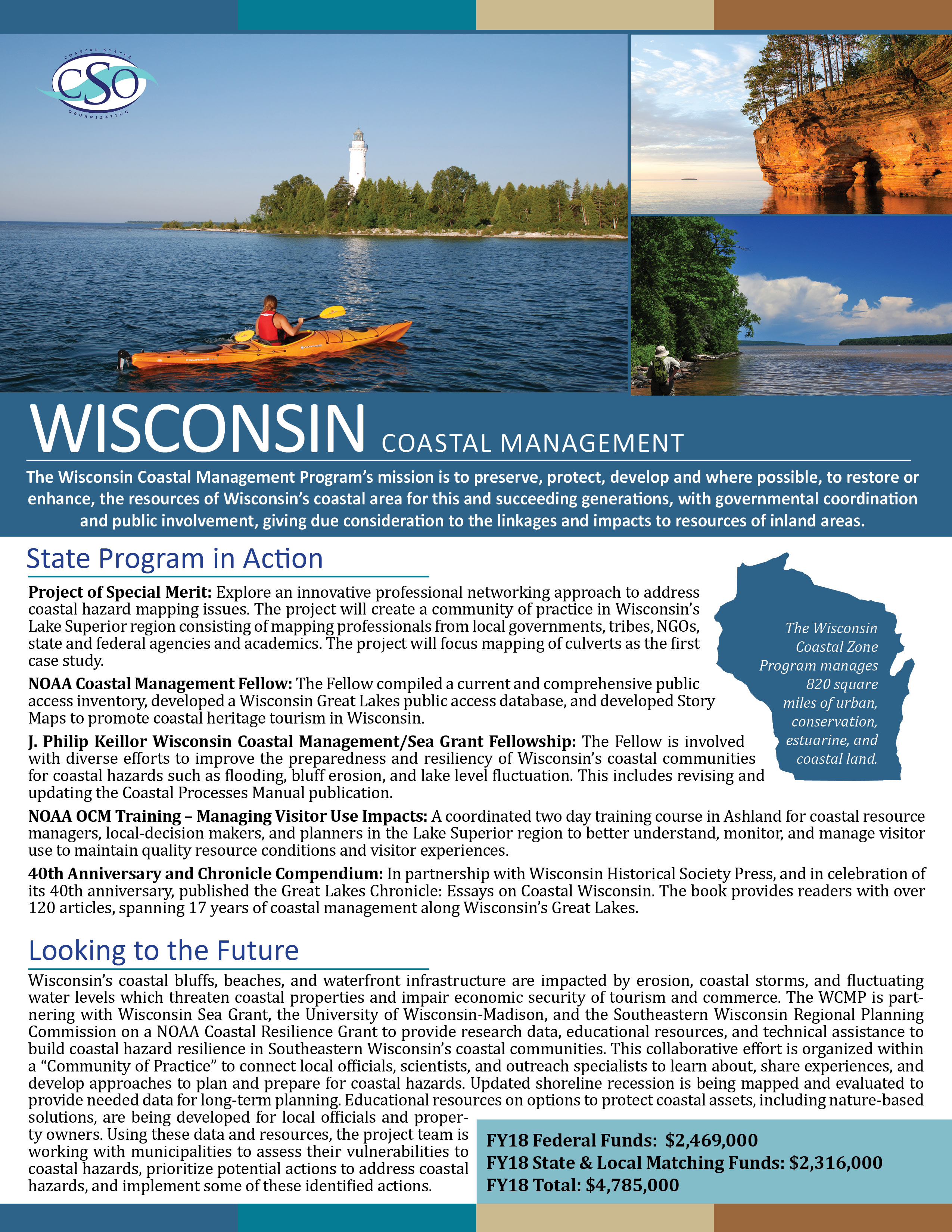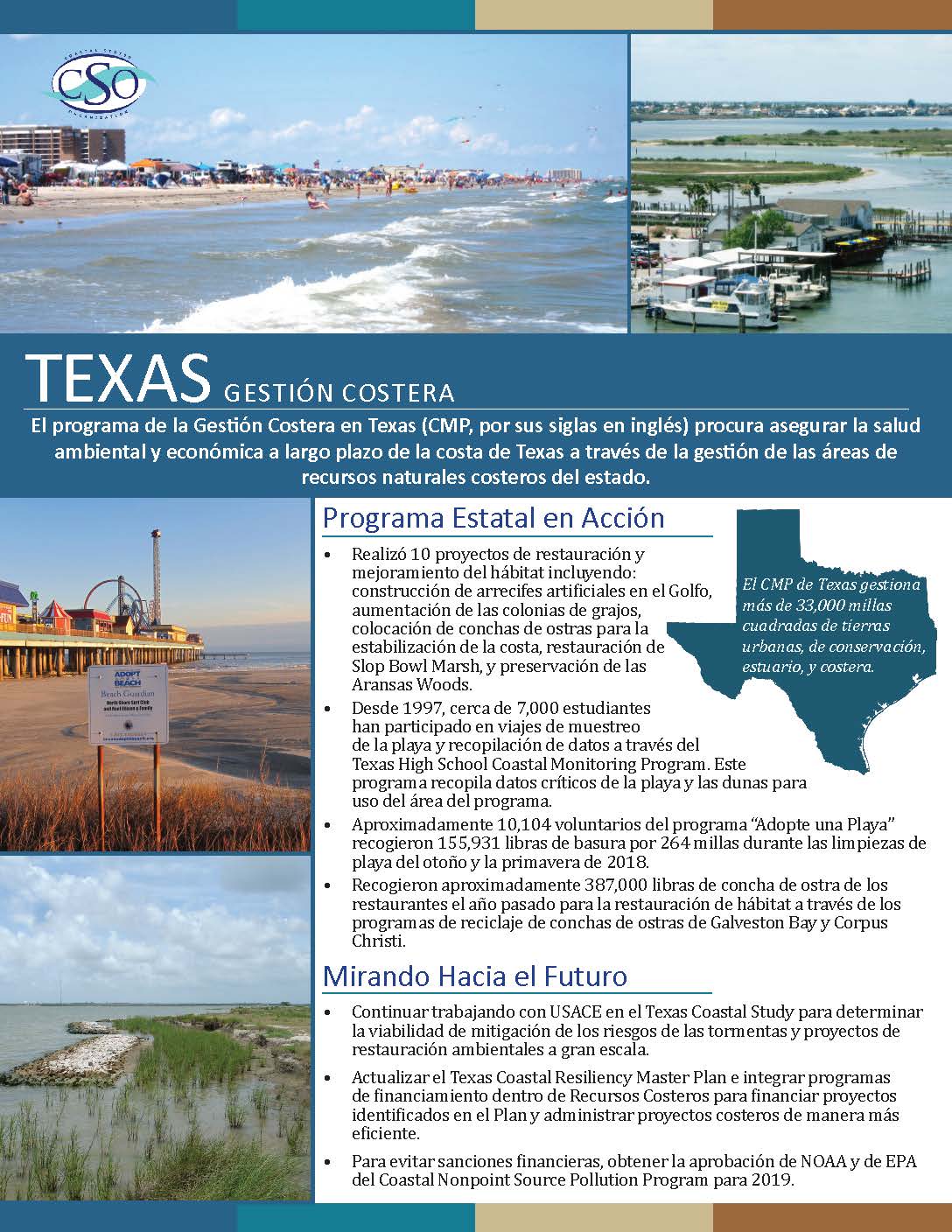Reports & Papers
Papers & Fact Sheets:
- State Fact Sheets
- National CZM Fact Sheet
- Coastal Issues Fact Sheets
- FEMA’s Hazard Mitigation Opportunities
- Spanish Fact Sheets
- CZMA Fact Sheet
Reports and Tools:
- Sediment Placement Regulations of U.S. Coastal States and Territories (CSO/ASBPA Final Report)
- Enhancing the Blue Economy Through Coastal Zone Management (CSO Report)
- Advancing Critical Solutions to Protect Coastal Communities (CSO Report)
- CRS Green Guide (CSO/ASFPM Tool)
- CZM Program Recommendations for National Tool Developers (Coastal Management publication)
- 40+ Years of Knowledge Put Into Practice (CSO Report)
State Fact Sheets
Coastal Issues
FEMA’s Hazard Mitigation Opportunities
Spanish Fact Sheets
Coastal Zone Management Act
Since the Coastal Zone Management Act (CZMA) was enacted in 1972 it has served as the foundation of the State-Federal partnership to manage the nation’s coasts. Today, there are 34 States and Territories with authorized Coastal Zone Management Programs that are advancing the goal of the CZMZ to preserve, protect, develop, and where possible to restore or enhance the resources of the nation’s coastal zone.
Click Here to Read More →
Sediment Placement Regulations Of U.S. Coastal States and Territories
The American Shore and Beach Preservation Association (ASBPA) and the Coastal States Organization (CSO) have partnered to highlight coastal program successes in managing sediment resources and elevate effective regional sediment management policies in the national spotlight. Many states and federal agencies have prioritized implementation of Regional Sediment Management (RSM) principles and are increasingly pursuing Beneficial Use of Dredged Materials (BUDM) opportunities, recognizing the cost savings and beneficial ecological outcomes these projects make possible. But challenges still remain. This project, funded by USACE Institute for Water Resources, aims to focus on the perceived challenge of conflicting state and federal policies and regulations around how dredged sediment can be used beneficially.
The final report, Sediment Placement Regulations of U.S. Coastal States and Territories: Towards Regional Sediment Management Implementation, provides a comparative analysis of federal- and state-level regulations on placing sediment in the coastal zone, with best practices, success stories and recommendations. This report is designed to inform coastal managers on best practices to better manage coastal sediment in their jurisdictions, increase BUDM, and catalyze systemic changes that promote comprehensive regional sediment management.
Click Here to Read More →
Click Below to Read More
Enhancing the Blue Economy Through Coastal Zone Management
The Blue Economy depends on the vibrant workforce, thriving industry, advanced infrastructure, and unparalleled natural resources of the nation’s coastal zone. Across the nation, the challenges confronting coastal communities are vast and complicated. To ensure our coastal zones continue to enrich and sustain the Blue Economy, robust, adaptive, and efficient coastal management is necessary.
For over 50 years, State and Territory Coastal Zone Management (CZM) Programs, in partnership with the National Oceanic and Atmospheric Administration (NOAA), have provided the effective management, beneficial use, protection, and development that the coastal zone needs. The State and Territory CZM Programs take the lead to manage coastal resources using their expertise and firsthand experience working on local issues, and NOAA provides guidance, funding, and program support.
State and Territory CZM Programs sustain the Blue Economy by assisting coastal communities to build coastal resilience, manage living resources, enhance tourism and recreation, support maritime transportation and commerce, and develop the new blue economy.
Click Here to Read More →
Click Below to Read More
2018 Report: The National Coastal Zone Management Program & the Blue Economy
Advancing Critical Solutions to Protect Coastal Communities
Millions of Americans work, play, and live along our nation’s beautiful shorelines. But life on the coast can be frequently disrupted by severe storms, earthquakes, chronic flooding, fluctuating water levels, and erosion. These hazards cause major economic harm to businesses, natural areas, and public infrastructure. America is searching for better ways to protect coasts, but there is no “one size fits all” solution. Each coastal community has its own physical, social, legal, and political characteristics, so solutions need to be tailored to their unique conditions.
The state coastal management programs established under the proven and successful Coastal Zone Management Act (CZMA) help communities address their coastal threats. This report illustrates the CZMA’s successful approach with 14 stories from communities across the country. Strong statewide coastal management creates resilient shorelines. The CZMA generates that strength. Thus, greater investment in this program will have national benefits. The CZMA must be central to America’s strategy for protecting coastal communities.
Click Here to Read More →
Click Below to Read More
CRS for Community Resilience – Green Guide
Developed through a collaboration between CSO and the Association of State Floodplain Managers, the CRS Green Guide is a web resource that connects local officials to actionable, plain-language information about 25 green elements in the 2017 CRS Coordinator’s Manual. These elements have beneficial impacts beyond flood-risk reduction such as improving water quality, restoring natural floodplain functions, creating recreational opportunities, and decreasing damage to infrastructure. The Green Guide provides:
- A plain language introduction to the CRS and best practices
- Element profiles with
- Implementation requirements
- Best practices for maximizing points
- Co-benefits beyond risk reduction
- Degree of difficulty to implement
- Information on stackable credits
- Success stories from communities across the nation
- Resource links to tools, manuals, and trainings
View the Green Guide at:
no.floods.org/GreenGuide
CZM Program Recommendations for National Tool Developers
Adapting to changing coastlines is an unprecedented planning challenge as coastal hazards, including those associated with climate change, influence all areas of resource management. Tools have been developed to aid in understanding coastal hazards and to facilitate the planning and implementation of adaptation strategies. State CZM Programs operate as trusted information brokers at the nexus between national resources and local needs. Here we provide seven recommendations for how to overcome the challenges identified with tool discovery, lack of trust, and the coarse spatial resolution of national tools. We also recommend leveraging CZM Program connections because they have the knowledge and expertise to identify solutions and disseminate information. While the recommendations presented here were taken from the perspective of state CZM Programs regarding coastal tools, the lessons learned may provide valuable insight into the tool development process for other resource management fields.
Click Below to Read the Coastal Management journal publication
Click Here to Read a Summary →
40+ Years of Knowledge Put Into Practice
Lessons Learned from Coastal Zone Management Programs
In 2018, 10 of the 34 participating states and territories celebrated their 40th anniversary of joining the National Coastal Zone Management (CZM) Program. While the challenges faced by each state program are as different as the coastlines they manage, the lesson we can learn from the work they have done in the last 40 years is singular. CZM Programs, which operate at the nexus of federal, state, and local government, are essential to the sustainable management of our Nation’s coasts. To create this poster, we interviewed 7 of the 10 coastal programs that celebrated their 40th anniversary in 2018. These are their stories.
